The food system needs to change its perspective on consumers and science. The issue isn’t that consumers don’t understand science—it’s that the food industry assumes science will be the definitive factor behind consumer decision making.
Refrigeration, precision planting, pasteurization and drought-tolerant hybrids are just a few examples of advances in technology that have provided countless benefits to society. Innovation and technology help us meet one of humanity’s most basic needs—the need to provide safe, nutritious food for the people we love.
It’s understandable that consumers are concerned and skeptical about food production. The consolidation, integration and application of technology that makes food safer, more available and more affordable than ever before also prompt concerns. Consumers wonder if technology benefits society or only those who control it. Skepticism abounds on the motivation of those in food and agriculture.
The food system’s traditional approach has been that consumers don’t understand because they haven’t been provided enough information. The reality is that consumers do not believe the food system has their best interests at heart. Consumers increasingly believe that because farms and food companies have dramatically increased in size and are using technology they don’t recognize or understand, the food system is likely to place profit ahead of public interest. No amount of science-based information is going to change that perception.
The goal should not be to win a scientific or social argument, but to find more meaningful and relevant methods to introduce science and technology in a way that encourages thoughtful consideration and informed decision making.
Instead of assuming the problem is uninformed consumers, the food system must reframe the issue. Consumers will continue to be uninformed and prone to believe the food system does not have their best interests at heart. The question is not what to do about recalcitrant consumers, it’s how we help consumers better understand that despite the changes in size, scale and technology, the food system will do the right thing for consumers.
The Peanut Case: Placing Profit Ahead of Public Interest
Shirley Almer looked forward to being home for Christmas.
The Minnesota grandmother had a lot to celebrate. A lung cancer survivor, she’d had brain tumor surgery in June and had now beaten cancer twice. She had been in a nursing home the last few weeks, recovering from an infection. Her daughter Ginger visited often. On two consecutive evenings, she made her mom peanut butter toast as they talked about the upcoming holiday and plans for Almer to come home.
On December 21, 2008, Almer fell gravely ill. Family rushed to her side at the local hospital. She died within hours.
A week later, the Minnesota Department of Health called her family. The cause of death had been determined to be salmonellosis. The state had experienced an outbreak of cases, and the contamination had been traced to a brand of peanut butter that was used at the nursing home.
In fact, an alarming number of Salmonella cases had occurred in the fall of 2008; many of those affected were elderly. Cliff Tousignant, a Korean War veteran with three Purple Heart medals, died in a Minnesota nursing home due to salmonellosis.
The cases were linked to peanut butter that had been processed at Peanut Corporation of America (PCA)’s facility in Blakely, GA. Investigators and media converged on the plant. Conditions discovered inside were disgusting. A leaky roof let rainwater drip on containers of food. Rats, insects and mold were all present. Birds flew through open windows, leaving droppings behind. It also came to light that PCA operated another plant in Texas that wasn’t licensed and had never been inspected.
A nationwide recall was issued that covered everything manufactured by PCA in the previous 2 years and more than 3,600 different products, including peanut butter, cookies, crackers, cereal, candy and even pet treats.
In all, more than 700 people in 46 states were sickened with Salmonella. Nine people died.
The investigation uncovered something even worse than unsanitary conditions. PCA and owner Stewart Parnell had knowingly sold unsafe, Salmonella-tainted food. His customers included big-name food corporations such as Kellogg and Sara Lee, as well as schools, institutions such as nursing homes and the federal government.
Over the previous years, PCA products had tested positive for Salmonella at least six times. The company routinely shipped product before waiting for test results. Parnell replied in one internal email, “[expletive] Just ship it. I cannot afford to lose another customer.” He approved sending out containers of product “covered in dust and rat crap.” When one lab consistently returned results positive for Salmonella, the peanut processor quit using it.
In June 2008, about 6 months before Shirley Almer got sick, an employee notified Parnell of more problems. “This lot is presumptive SALMONELLA!!!” she wrote. Parnell seemed unconcerned. “I go thru this about once a week…I will hold my breath…again.”
In an email in October, the plant manager reported positive tests for Salmonella on 400 cases of product. Parnell’s reply focused only on the bottom line. “The time lapse besides the cost is costing us huge $$$$$ and causing obviously a huge lapse in time from the time we pick up peanuts until the time we can invoice…we need to protect ourself.”
While Parnell was worried about “$$$$$,” his actions proved very costly. PCA went belly up within days. Sales of all types of peanut butter plunged. The loss to the nation’s peanut growers was estimated at more than $225 million.
Such blatant disregard for safety and public health spurred the U.S. Department of Justice to charge Parnell with a string of federal crimes. In September 2014, a jury found him guilty of 71 counts including conspiracy, interstate shipments fraud, obstruction of justice and introducing adulterated food into interstate commerce with intent to defraud or mislead. His brother Michael was convicted on 29 counts of similar crimes. Stewart Parnell was later sentenced to 28 years in prison.
For the victims’ families, it was justice served.
“If Stewart Parnell is convicted and does jail time, it might make someone else think twice,” said Lou Tousignant, whose father had died. “He played Russian roulette with his products. How can you defend that?”
You can’t. Parnell’s actions are indefensible. And that is the challenge facing Big Food.
Eroding Public Trust
During the last 45 years, while Americans have been taught not to trust institutions, the food business has grown into a large, complex system. Sweeping consolidation, integration, industrialization and application of technology have caused the public to wonder whether the food system has become an institution and as such is no longer worthy of trust.
No doubt about it, food is big business. Consumers experience this firsthand when they trek to the store to purchase their supplies. The nation’s first grocery store opened in Memphis, TN, in 1916 when Piggly Wiggly introduced an innovative concept—shoppers going around picking up items for themselves instead of giving their list to a clerk who would gather the goods. The median-size grocery store now measures 46,500 square feet, a trend that has been steadily increasing.
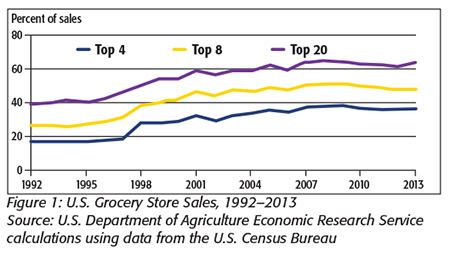 Grocery chains have also grown larger as small, neighborhood stores become bygones. In 1993, the top 20 food retailers controlled 40 percent of sales. Two decades later, they control more than 60 percent (Figure 1). Walmart, which opened its first grocery store in 1998, now takes in $1 of every $4 Americans spend on food. Americans are conflicted when it comes to Walmart. The company earned both the highest sales and the lowest customer ratings.
Grocery chains have also grown larger as small, neighborhood stores become bygones. In 1993, the top 20 food retailers controlled 40 percent of sales. Two decades later, they control more than 60 percent (Figure 1). Walmart, which opened its first grocery store in 1998, now takes in $1 of every $4 Americans spend on food. Americans are conflicted when it comes to Walmart. The company earned both the highest sales and the lowest customer ratings.
The supply chain that delivers food to the stores has also become the domain of Big Food. Data from the Government Accounting Office illustrate how food processing became concentrated in a 25-year period (Table 1).
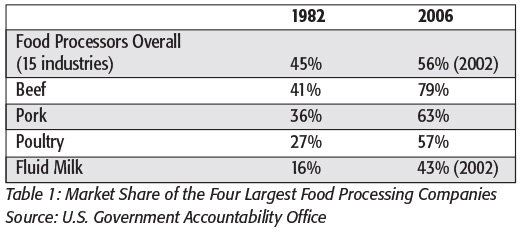
In the decade since 2006, the trend has continued toward fewer, bigger firms:
• Beef: Four packers produce 85 percent of beef.
• Flour: Three companies control 55 percent of flour milling.
• Poultry: Ten companies process 83 percent of chicken.
• Milk: Fifty dairy cooperatives produce 79 percent of milk.
• Pork: Four packers handle 65 percent of processing.
• Lamb: Four packers control 65 percent of processing.
• Beverage: Three firms control 89 percent of soft drink sales.
Since World War II, the number of farms and farmers has declined dramatically. In 1950, the United States had 5.6 million farms. That number is now 2.1 million. Farms themselves are larger, with the average now 434 acres, about one-third larger than in 1960.
Traditionally, public trust of our food and the people who grow it has been taken for granted. Family farms and all they represent are deeply rooted in our culture. Thomas Jefferson extolled the yeoman farmer as the backbone of democracy.
But just as the techniques of food production and processing have progressed tremendously, consumer attitudes about food have changed. Technology and innovation have made food safer, more affordable and more available than ever before. At the same time, consolidation, integration and technological advances in the way food is produced have increasingly resulted in the food system’s being viewed as an institution.
Outrage Factors
In these ways, Big Food is similar to Big Oil, Big Pharma or Big Banking—seemingly destined to join the Hall of Shame for America’s Most Hated.
And yet, food is different. Cooking dinner is nothing like completing a financial audit.
Food is so incredibly personal. It is necessary for survival. Food insecurity causes tremendous anxiety for a person, a family, a nation. Where food insecurity exists in a region of the globe, it almost always results in conflict. And when conflict erupts, it frequently results in food insecurity.
We provide food to those who are most vulnerable—children, the elderly, those who can’t provide for themselves. Rarely do our gatherings not center around a meal. Food is integral to cultural identity, religious ceremonies and celebrations of family and community.
Big Food is susceptible to growing public sentiment that profit is being placed ahead of the public interest. When this triggers social outrage, it can have profound ripple effects, as we have already seen.
But why do some issues erupt into crisis while others seem to fade away? The Center for Food Integrity (CFI) looked at specific factors to get a better understanding of how some lead to social outrage. The research found two factors are critical to igniting outrage: First, if the issue is a “concern” to the public, and second, if it has an “impact” on those perceived as vulnerable. Specifically, issues that can have an impact on “me and my family” heighten these factors. That’s why food safety and the impact of diet on health top the list of issues on the edge of outrage, waiting for a triggering event to push them over the brink.
In 1993, four children died during an incident often described as a wakeup call for the industry. They ate ground beef that was contaminated with Escherichia coli and served at Jack in the Box restaurants. The victims ranged in age from 6 years to 17 months. The shortened lives of these four children triggered social outrage that continues to affect food safety research and policy.
PCA cooked up the perfect recipe for social outrage. Those internal emails spelled out that the corporation put profit ahead of everything else. The victims were vulnerable and unsuspecting—elderly patients in nursing homes.
The frequency and visibility of foodborne illness created sustained public concern that served as a catalyst for government intervention. The most deadly was an outbreak of Listeria in cantaloupe in 2011. The contamination killed more than 30 people and was caused by contaminated equipment at the farm where the melons were washed and processed.
Other cases have involved celery, eggs, cilantro, berries and cucumbers.
In the wake of these deadly foodborne illnesses, the U.S. Food and Drug Administration enacted the Food Safety Modernization Act (FSMA). It is the most sweeping reform of food safety laws in the U.S. in more than 70 years. The goal of the massive program is to shift the food safety focus from responding to contamination to preventing it.
The program is estimated to have a net cost to the government of $2.2 billion over 5 years. No estimates are yet available on the cost to industry.
Nor is it possible to determine whether the act has impacted trust—do consumers feel their food is safer? In 2015, while FSMA was awaiting implementation, Listeria contamination in Blue Bell ice cream caused 10 people to be hospitalized and three people died.
Social License and Shared Values
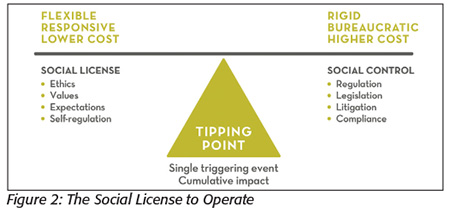 Every organization, no matter how large or small, operates with some level of social license. Social license (Figure 2) is the privilege of operating with minimal formalized restrictions (regulation, legislation or market-based mandates) based on maintaining public trust by doing what’s right. Social license is granted when you operate in a way that is consistent with the ethics, values and expectations of your stakeholders. Your stakeholders include customers, employees, the local community, regulators, legislators and the media.
Every organization, no matter how large or small, operates with some level of social license. Social license (Figure 2) is the privilege of operating with minimal formalized restrictions (regulation, legislation or market-based mandates) based on maintaining public trust by doing what’s right. Social license is granted when you operate in a way that is consistent with the ethics, values and expectations of your stakeholders. Your stakeholders include customers, employees, the local community, regulators, legislators and the media.
Once lost, either through a single event or a series of events that reduce or eliminate public trust, social license is replaced with social control, which involves regulation, legislation, litigation or market action designed to compel you to perform to the expectations of your stakeholders. Operating with social license is flexible and low-cost. Operating with a high degree of social control increases costs, reduces operational flexibility and increases bureaucratic compliance.
The social license once enjoyed by food companies and producers is at risk as a growing group of skeptical stakeholders raises questions about whether today’s food system is worthy of public trust. Once public trust is lost, the tipping point is crossed and high-cost social control replaces flexible, lower-cost social license. Once social control is in place, it can be modified, but social license is never fully recovered. Maintaining social license has real economic value. It is not just the right thing to do, it is enlightened self-interest.
The question then becomes, what can be done to maintain public trust that grants social license and protects freedom to operate?
 CFI introduced a research-based consumer trust model in 2006 and determined the three primary elements that drive trust—confidence, competence and influential others (Figure 3).
CFI introduced a research-based consumer trust model in 2006 and determined the three primary elements that drive trust—confidence, competence and influential others (Figure 3).
Confidence is related to perceived shared values and ethics and a belief that an individual or group will do the right thing. Competence involves skills, ability and technical capacity. We have traditionally focused our communication about food on competence, assuming stakeholders will make logical data-based decisions if provided credible information. Influential others include family and friends as well as respected, credentialed individuals such as doctors and veterinarians.
A nationwide consumer survey in 2007 determined the roles that confidence, competence and influential others play in creating and maintaining trust. Consumers were asked to rate their level of confidence, perceived competence and trust in various groups of influential others in the food system on questions related to food safety, environmental protection, nutrition, animal well-being and worker care.
The results were consistent and conclusive. On every issue, confidence, or shared values, was three to five times more important than competence for consumers in determining whom they will trust in the food system.
These results were a call to action for everyone in the food industry. No longer is it sufficient to rely solely on science or to attack our attackers as a means of protecting self-interest. This new environment requires new ways of engaging and new methods of communicating if we want to build trust, earn and maintain social license and protect our freedom to operate.
A New Way of Communicating
Building trust isn’t just about giving consumers more science, research and information. It’s not enough anymore. Science tells us if we can do something; society tells us if we should. We have to be able to understand the difference and cannot substitute scientific verification for ethical justification.
CFI’s research shows that to build consumer trust, it’s crucial to demonstrate that you share their values when it comes to the things consumers care most about, such as safe food, quality nutrition, good animal care and conscientious environmental stewardship. Helping people understand that we value what is important to them paves the way for introducing science into the conversation.
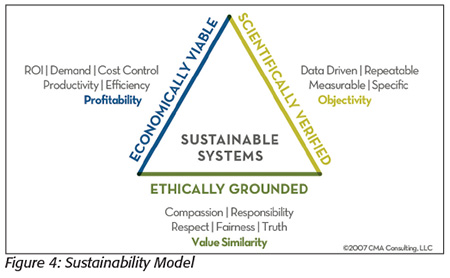 To be sustainable, communication must also be grounded in ethics, then supported by science and economics (Figure 4). The information we provide impacts knowledge. But ethics (or values) impact feelings and beliefs, which drive consumer decisions.
To be sustainable, communication must also be grounded in ethics, then supported by science and economics (Figure 4). The information we provide impacts knowledge. But ethics (or values) impact feelings and beliefs, which drive consumer decisions.
We’re seeing increasing pressure on branded food companies from nongovernmental organizations (NGOs) and advocacy groups on specific issues. How can we do a better job engaging consumers in a way that helps them understand and even support food production?
Rather than defending or responding with science, we need to listen to and acknowledge consumer concerns, and engage in a conversation that helps us recognize what they want from today’s food system. This then allows us to help consumers understand what we are doing to address their concerns and also understand that what we are doing is probably more consistent with what they want us to be doing than they might realize. It also provides the opportunity to take real steps to increase transparency.
Food system stakeholders must develop new models for authentic engagement. In this dynamic new environment, producers and processors are inextricably linked to their customers and NGOs interested in food issues. The question is no longer “Will you be transparent?” but rather, “How will you protect your social license in an age of radical transparency?”
The Big Three
Major issues the food system should be addressing include:
• Big food bias
• The relationship between diet and health
• Increased concern over food ingredients
1) Big Food Bias:
As discussed earlier, consolidation, integration and other issues have contributed to the public perception that “big is bad” and big food companies are going to put profit ahead of public interest.
CFI’s research has shown the only way to overcome “big food bias” is through increased transparency.
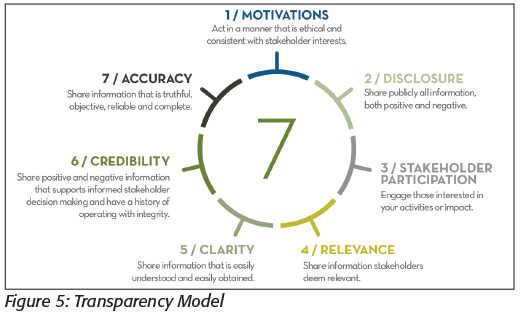 While consumers have been asking for transparency, there have been varying attempts at defining it. CFI’s research has not only defined it but it also provides a clear path to effectively address growing skepticism about food. Effectively implementing CFI’s Transparency Model (Figure 5) can help companies and organizations build trust with their most important audiences.
While consumers have been asking for transparency, there have been varying attempts at defining it. CFI’s research has not only defined it but it also provides a clear path to effectively address growing skepticism about food. Effectively implementing CFI’s Transparency Model (Figure 5) can help companies and organizations build trust with their most important audiences.
Motivation is only one of the seven points in the model, but it’s a dominant one. Consumer perception that big companies are putting profit ahead of public interest must be overcome before science-based information can be introduced into the conversation. The process used to address public concerns is also very important. Consumers ask, “Are you listening? Are you acknowledging I’ve been heard? Are you explaining how and why you make decisions?”
Overcoming this perceived motivation requires a commitment to engaging consistently and over time. A proven process shows that your motivations are aligned with consumers and that you are being transparent.
In the past, our responses to concerns about Big Food may have sounded like this:
“The size and scale of operations today allow us to produce food more efficiently. The new technology used today is based on sound science and allows us to produce more food and keep food prices down.”
Compare a response utilizing shared values:
“We understand that food is a personal and emotional issue. It involves the health and well-being of family and friends. It’s understandable that people are concerned about today’s food production methods because there’s been dramatic change over the last few decades. While methods used today may look different, it’s important to realize that today’s food producers have the same commitment to providing safe, nutritious, affordable food as previous generations.”
2) Relationship between Diet and Health:
Addressing this pivotal issue needs to start with the food system’s embracing consumer skepticism and their concerns about diet and health. As a country, we now spend more on diet-related healthcare than on tobacco-related healthcare. As baby boomers and millennials continue to raise questions, the food system needs to embrace the skepticism and be willing to transparently and authentically answer questions about how diet impacts health. Candid discussions on the issue will better position us to gauge the public dialogue about many factors that relate to diet and health.
The issue of diet and health contains a number of contributing factors. It’s a combination of what and how much people eat as well as fitness and exercise. But unless we embrace the consumer skepticism and are willing to acknowledge the concern, any discussion about other factors comes across as defensive and deflecting and undermines trust. The food system needs to avoid sounding as if it’s not willing to take responsibility or to accept any contribution to the concern.
In the past, when food’s role in public health issues has been called into question, a company’s response might have been:
“Studies show that the leading chronic health issues in America are more related to sedentary lifestyles than ingredients and the processes we use to produce food. People need to get out and exercise more.”
Injecting shared values into the response would increase chances of connecting with your audience:
“Health and fitness is important to everyone, and we acknowledge diet as a key component of this issue. That’s why we’ve established a website to provide not only nutrition information on our products but also advice on healthy living. A combination of healthy weight, prudent diet and daily physical activity plays a role in improved health, and we want to be a resource to people on this very important issue.”
3) Concern over Food Ingredients:
More specifically, ingredients that are hard to pronounce and can’t be defended solely by science.
Concern on this issue was evident in the qualitative portion of CFI’s latest consumer research. Focus groups showed us that consumers are increasingly concerned and confused by complex ingredients they believe don’t have consumer benefits. Many believe these ingredients only benefit food processors and manufacturers.
For the food system to be given the social license to continue to use these ingredients, we need to not only explain what the ingredients are in easy-to-understand language but to also engage in conversations about how they have a societal benefit.
One example would be the ingredients used in bread that allow consumers to keep it in their pantries longer without it molding—a definite consumer benefit. The ability to preserve a loaf of bread longer reduces food waste and saves money. When food is wasted, it requires additional resources to replace it as well as resources to dispose of it. These ingredients have benefits for consumers and for society as a whole. Talking only about preservatives carries an “ick” factor for consumers unless you help them understand the big picture.
In the past, when traditional food ingredients were called into question, a company’s response might have been:
“Based on peer-reviewed studies, this ingredient is generally recognized as safe and approved by the Food and Drug Administration. It’s something that should not be cause for consumer concern.”
A better response, using shared values, could be:
“We know people are concerned about our use of this ingredient because we’ve heard it loud and clear from our customers. We share that concern and want food for our families to be healthful and safe. That’s why we’re happy to answer questions about this particular ingredient (then talk about why it’s used and the societal benefits it provides). Are there other ingredients that you’re concerned about? We’d like to be a resource if you have more questions.”
We discussed earlier the need to overcome perceived motivation before science-based information can be introduced into consumer engagement. One U.S. food company is developing a major research and development laboratory to focus on products that don’t include artificial ingredients. It is essentially saying to consumers, “We understand your concern about diet and health. While science tells us our ingredients are safe, we appreciate your concerns and that’s why we’re investing money to look for alternatives.”
This is the type of action that can clarify motivation. Perceptions will change with continuous use of these kinds of messages.
It’s about Trust
How technical and scientific information is introduced is key to supporting informed decision making by today’s consumers. Our research clearly shows that once a values-based connection has been made, permission is granted to introduce technical information. Simply having science on your side is clearly not enough to encourage and support informed decision making. Being right is not enough to ensure information is considered in the social decision-making process.
As we increase both the distance most consumers have from food production and the level of technology we implement, we must dramatically improve our ability and commitment to build trust with consumers and other stakeholders who grant social license. This will require a new way of thinking, a new way of operating and a new way of communicating.
To be successful, we have to build and communicate an ethical foundation for our activity and demonstrate our commitment to practices that are ethically grounded, scientifically verified and economically viable.
Charlie Arnot is CEO of CFI, a national nonprofit organization established in 2007 to build consumer trust and confidence in today’s food system.
When Consumers and Science Collide




